
Back فوشيا (نظام تشغيل) Arabic Google Fuchsia Azerbaijani Fuchsia BAR Google Fuchsia Catalan Fuchsia (operační systém) Czech Google Fuchsia German Google Fuchsia Spanish گوگل فیوشا Persian Fuchsia OS Finnish Google Fuchsia French
 | |
 The Fuchsia GUI | |
| Developer | |
|---|---|
| Written in | Rust, C++, C, Dart, Go, Python, assembly language[2][3] |
| OS family | Capability-based[1] |
| Working state | Current |
| Source model | Open source |
| Initial release | May 25, 2021 |
| Latest release | F20[4] |
| Repository | |
| Available in | English |
| Platforms | ARM64, x86-64 |
| Kernel type | Microkernel |
| Influenced by | Pink, Android, Unix kernel (but not Unix-like), iOS |
| Default user interface | Ermine |
| License | BSD, MIT, Apache License 2.0 |
| Official website | fuchsia |
| Articles in the series | |
| Taligent | |
Fuchsia is an open-source capability-based operating system developed by Google. In contrast to Google's Linux-based operating systems such as ChromeOS and Android, Fuchsia is based on a custom kernel named Zircon. It publicly debuted as a self-hosted git repository in August 2016 without any official corporate announcement. After years of development, its official product launch was in 2021 on the first-generation Google Nest Hub, replacing its original Linux-based Cast OS.
- ^ "Language usage in Fuchsia". Noober Info. June 15, 2021. Archived from the original on August 24, 2022. Retrieved August 24, 2022.
- ^ "Google Fuchsia OS: The next big thing on the internet – Next-Gen OS". Fuchsia.
- ^ "C++ in Zircon". Fuchsia. Retrieved February 7, 2023.
- ^ "Fuchsia F20 release notes". Retrieved November 23, 2024.